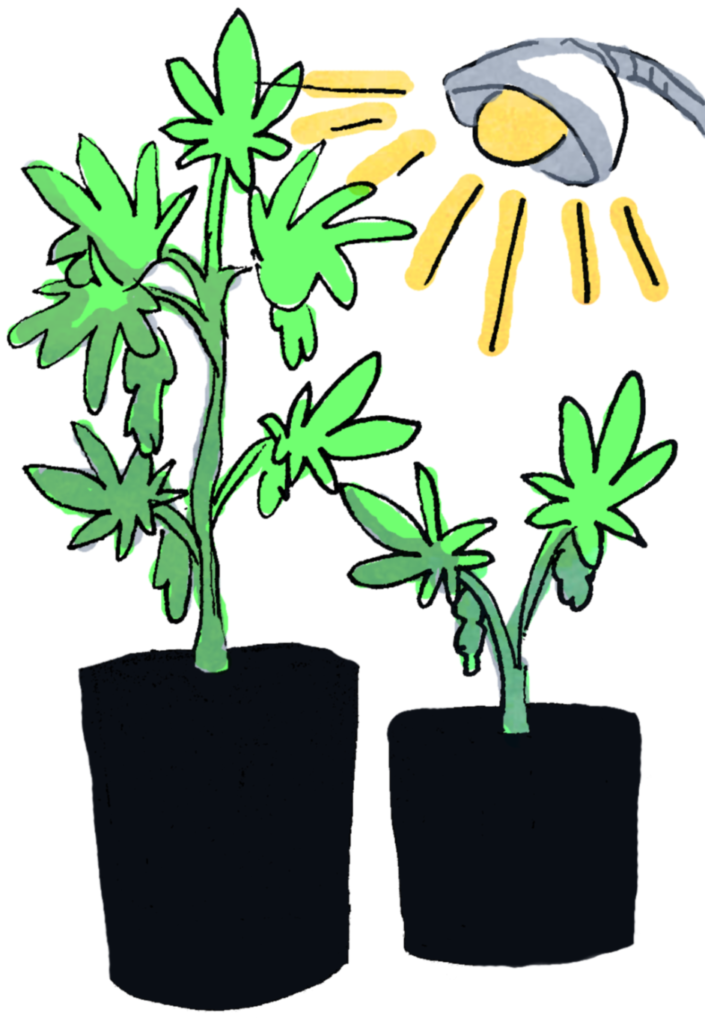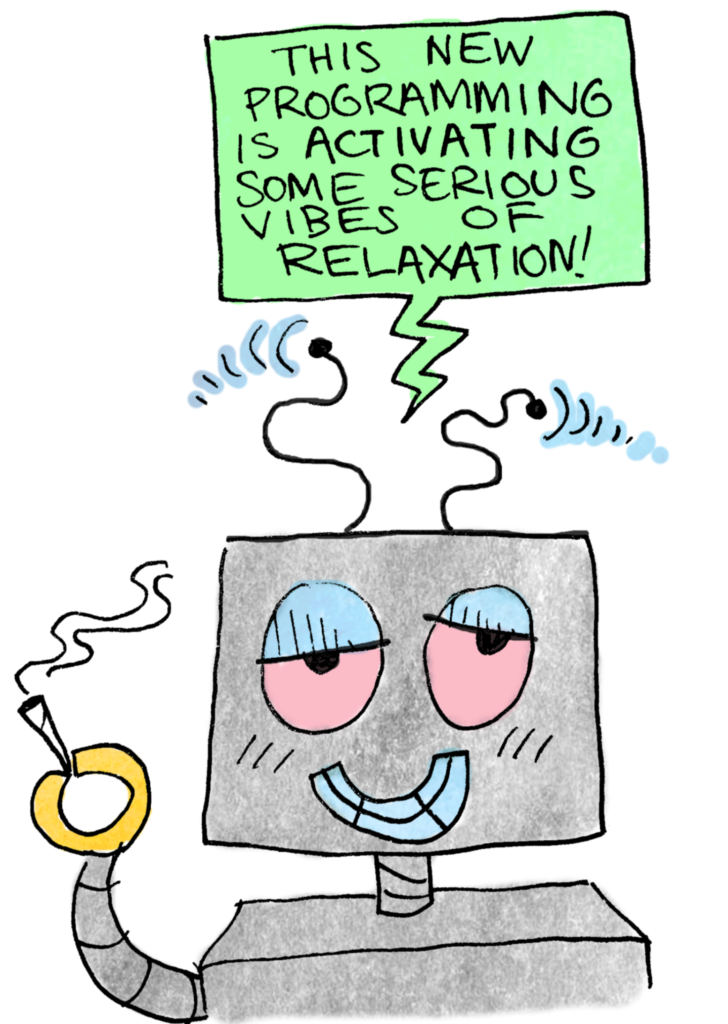Shadowy figures move back and forth among the cannabis plants, stopping periodically to water a plant, tending to its individual needs. But these figures are not humans; they are an advanced technology.
These are cannabis robots, a new form of artificial intelligence built by company William Bond Ai, which founder, Nathaniel Morris, believes could one day be commonplace in cannabis production facilities around the world.
Morris is no stranger to the cannabis industry. He has been involved with cannabis in one way or another since the age of 12 and has spent the past 20 years working in the industry.
Morris’ newest venture, William Bond Ai, is believed to have the potential to impact the cannabis industry in a big way, by introducing a new technology into a currently labour-intensive production process.
“I’m kind of a futurist–I like technology, and it’s been fun to anticipate what the next thing is going to be and where the technology is going,” he said.
Morris’ robot, called “William,” is designed to nurture cannabis plants and help in breeding plants to develop specific traits. William is also designed to help study the effects of cannabis on people who use it for medical purposes, such as epilepsy.
“Everyone, when they hear robotics, they picture a robot pretending to be a human. But humans aren’t actually a good shape for a robot . . . there’s a reason why this is better at growing weed then humans, it doesn’t have to crouch down.” – Nathaniel Morris, founder of William Bond Ai
He altered existing farming machines–robot farming technology known as FarmBots–to grow cannabis plants. He did so by taking the app that controls the robot and inserting an artificial intelligence so the robot would continue to grow and learn. This, in turn, created “William.”
Unlike the typical “robot” appearance, similar to a human, William is a robotic arm attached to two tracks that allows it to move horizontally over a cannabis crop.
“Everyone, when they hear robotics, they picture a robot pretending to be a human. But humans aren’t actually a good shape for a robot . . . there’s a reason why this is better at growing weed then humans, it doesn’t have to crouch down,” Morris said.
How William works
According to Morris, William is capable of doing things most humans are unable to do, such as using infrared radiation to detect levels of THC or Cannabinoid (CBD) in cannabis plants. William can also use infrared technology to detect when a plant is under stress.
“A human eye is not great at analyzing plants,” Morris said.
Plants absorb spectrums of UVB light that humans can’t see. But, with a specially designed camera, William is able to analyze the plants and see which are properly photosynthesizing.
If the plants are properly absorbing the UVB light, the plant will show up pink, but if the plant is damaged, it will not show up pink. William is then able to treat or remove the damaged area.
William is also able to compare the amount of water in the soil to the amount that has been programmed into his system as being an ideal quantity, and water when needed.
William allows for a more organic production for cannabis; instead of spraying chemicals on the plants to get rid of weeds, William has a different approach, and will take note of where he planted a seed, then if something grows in the soil in a different spot, he will recognize it as weed and destroy it.
Because of William’s quick learning and early detection, this robot could exponentially limit crop failure, an important issue in cannabis production.
Far more than a simple gardener, William is more of a teacher, and was created to offer an information-sharing platform for other robotics. For example, William will track each event that takes place within a crop, such as the appearance of plant pests like spider mites, and learn to identify the early states so it can detect problems as soon as they happen. William can then share this information with other robots, making them as experienced as it is in the agriculture field.
“Each robot is like a master grower that learns from the other robots and gets better and better over time,” Morris said.
William’s plans
Morris said he believes that William has a lot of potential. Not only is Morris hoping to learn how to grow cannabis in more efficient and better ways, he also wants to use William to help people with medical disabilities that can be managed by cannabis.
Currently, the process for deciding which cannabis to give to individuals for their medical problems is based on the disease they have, rather than which cannabis is best suited for the individual, according to Ashleigh Koeslag, operations manager at Medi-Green Medical Marijuana Company in Perth, Ont.
Koeslag commented that after the process of deciding the type of cannabis to use, they will then address whether THC, CBD or a balance of both will be needed for treatment of a patient’s symptoms.
Morris is hoping William will be able to change the medical process by introducing a number of different techniques, including a health app.
Kinect Training is a game that was created by Nike and developed by personal trainers. It was originally intended to teach users work out techniques, such as squats, and will track how well they are performing physically over time. This app has been repurposed by Morris and used to help track how cannabis helps improve physical performance for people suffering from movement disorders, such as Parkinson’s disease.
Morris is also using a repurposed 14-channel electroencephalogram (EEG) headset that people can wear while using the game. The headset will track how a subject’s brain is being affected by the dosage of cannabis used, and by the specific type.
“Say you have Parkinson’s disease, or a movement disorder, and we give you 20 milligrams of CBD and we notice there is a 10 per cent improvement on certain physical movements you are attempting to do. We would then give you 40 milligrams and your improvement goes up to 40 per cent. Finally, we get up to 120 milligrams and [the improvement] starts to plateau,” Morris said.
Morris is building a business on the assumption he can develop a process that will match the most suitable cannabinoids to specific medical conditions, which he said he believes could change treatment methods.
Morris believes William has the potential to change the cannabis industry, and communities such as Smiths Falls, Ont., which has experienced economic development in response to cannabis legalization. Smiths Falls is home to the Canopy Growth Corporation (CGC), the largest cannabis company in the world.
Smiths Falls’ Mayor Shawn Pankow commented that he is excited to see Morris’ company succeed. Pankow said he believes Morris has “a wealth of relevant experience and a commitment to help Smiths Falls develop its cannabis industry.”
Concerns
Not everyone sees Morris’ company as being a good thing; William’s impact on the cannabis industry could mean a loss of jobs.
According to a Global News article, currently there are around 10,500 people employed in the cannabis industry, but it is estimated this number will climb to 150,000 within six to seven years.
Deepak Anand, vice-president of Cannabis Compliance, a Canadian cannabis consulting firm, believes robotics has the potential to cost jobs in the cannabis industry.
“Like with every other industry, AI is going to replace jobs to a great extent in the cannabis industry,” Anand said.
According to Morris, the loss of jobs in the cannabis industry will not be an issue with William. Morris recognizes that jobs will be taken over by the automatization of the cannabis industry, but, he says since the industry is so new and constantly changing, there is no real threat of people losing their jobs. The cannabis industry can’t hire enough people to keep up with the growth.
“In the near term, everyone who has gone into the industry will still have their jobs,” he said.
Looking to the future
Morris has big plans for William Bond Ai, which is one of the reasons why he is located in Smiths Falls, considered Canada’s cannabis capital.
While Morris said he didn’t make the move to Smiths Falls specifically because of the CGC, he said he intends to hopefully sell his product to cannabis manufacturers such as the CGC once it is finished development.
While William is still in the beta stage and is being trained to efficiently grow cannabis, Morris said William will change the way agriculture work is done in the cannabis industry and he said he hopes that one day he will see cannabis robots like William in every cannabis facility.
According to him, William will be the “superpower” the cannabis industry has been waiting for, and the analyzing of plants and its components will finally be something the industry is able to achieve.
Since cannabis has over 300 chemicals in it, rather than just one or two like other plants, Morris said that the world has not had the right tools in the past to properly analyze all of its medical components. He said that his invention is a game changer for analyzing cannabis in the cannabis industry.
“This is the first time science has had a tool worthy of the challenge of studying cannabis.” – William Morris.
Morris said he hopes the technology will eventually makes it way to CGC, but he stated CGC is not his full goal for William; he hopes William will eventually take over and automatize cannabis production completely, across the industry.
“Sure, Canopy is a potential client down the road, but the real opportunity here is the global stage Canopy has provided us. It’s not just one company, it’s all of them.”






